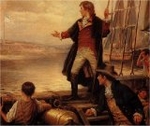
Worksheets and No Prep Teaching Resources
Reading Comprehension Worksheets
A New Nation
(1776-1830)

A New Nation
(1776-1830)
 Worksheets and No Prep Teaching Resources Reading Comprehension Worksheets A New Nation (1776-1830) |
 A New Nation (1776-1830) |
| edHelper's suggested reading level: | grades 4 to 6 | |
| Flesch-Kincaid grade level: | 5.58 |
|
Sequoyah
By Jane Runyon |

|
 1 Sequoyah was a very artistic Native American. He was born in the 1770's in a camp along the Tennessee River. His mother was a member of the Paint Clan, and his father was a white man. He was raised in the Cherokee tradition. From the time he was very young, he loved to draw. He would draw the animals he saw in the woods near his camp. He would draw the flowers and trees which surrounded his home. He was injured in a hunting accident when he was young. This injury kept him from hunting and fishing like many of his friends. He spent much of his time thinking and drawing.
1 Sequoyah was a very artistic Native American. He was born in the 1770's in a camp along the Tennessee River. His mother was a member of the Paint Clan, and his father was a white man. He was raised in the Cherokee tradition. From the time he was very young, he loved to draw. He would draw the animals he saw in the woods near his camp. He would draw the flowers and trees which surrounded his home. He was injured in a hunting accident when he was young. This injury kept him from hunting and fishing like many of his friends. He spent much of his time thinking and drawing. |
Create Weekly Reading Books
Prepare for an entire week at once! |
| Leave your feedback on Sequoyah (use this link if you found an error in the story) |
 |
A New Nation (1776-1830) |
 |
United States
|
|
|
 | Fifty States Theme Unit |
 |
Document Based Activities |